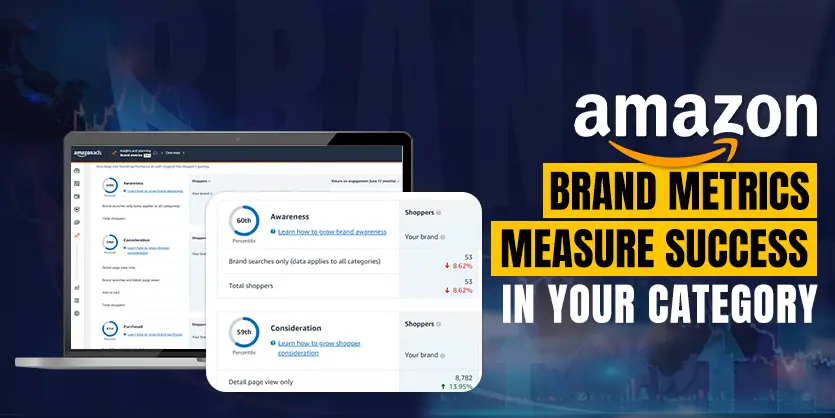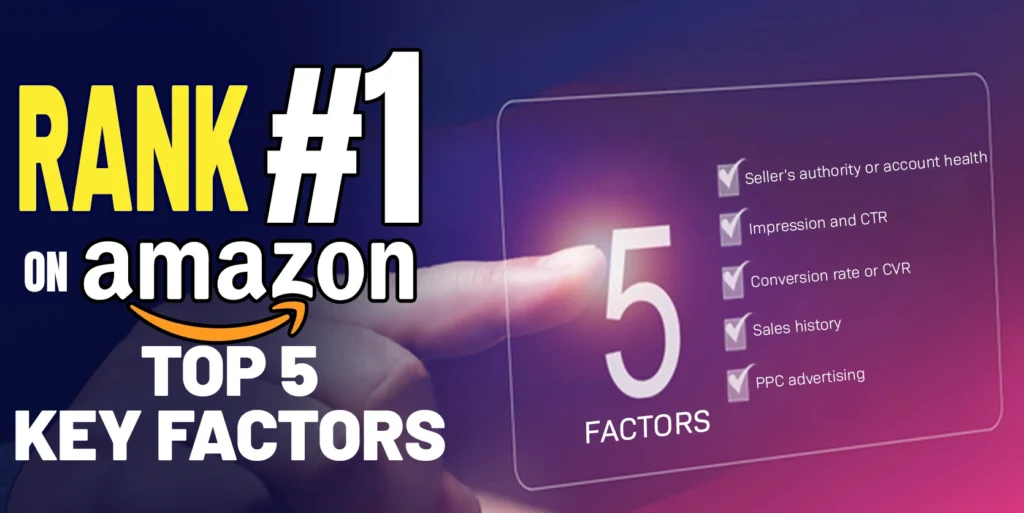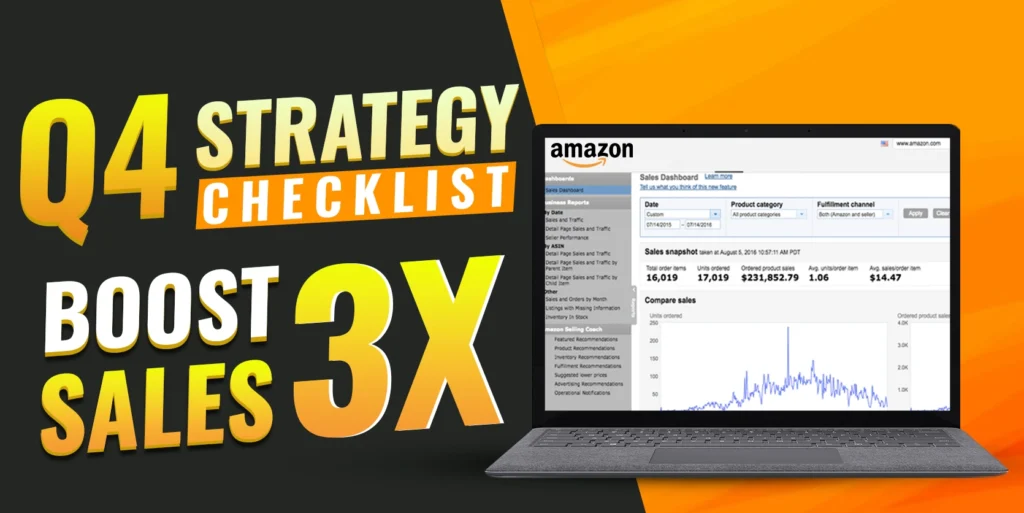Nearly 50% of Amazon customers want to try new products. But most of the brands on Amazon aren’t achieving the sales they expected. Customers consider several factors while buying, such as price, rating reviews, prime eligibility, and other factors. If you want to understand the behavior of customers, then brand metrics will help you out. By carefully analyzing your brand performance and strategically using Amazon PPC, you can turn things around and drive significant sales growth. In this article, we’ll explore how to use these metrics to measure your brand’s success and utilize Amazon PPC to build a strong, competitive brand.
In this blog post, we’ll explore how to utilize Amazon Brand Metrics effectively, alongside other Amazon PPC strategies, such as Amazon Sponsored Ads and the Amazon Search Query Report, to boost your brand’s visibility and sales.
In this article, we will cover:
- What are Amazon Brand Metrics?
- Why Seller Should You Care About Brand Metrics?
- The Available Brand Metrics on Amazon
- How to Access Brand Metrics Report?
- How to Use Brand Metrics Insights?
- Final Thoughts on Brand Metrics Report
1. What are Amazon Brand Metrics?
Amazon Brand Metrics are a set of data-driven insights provided by Amazon. These insights help brand owners to evaluate and improve their performance on the platform. Sellers will get a comprehensive view of how customers are engaging with brands and their products. From this data, sellers will easily understand the impact, customer loyalty, and overall market position of their brand on Amazon.
Analyzing the Marketing Funnel
Amazon Brand Metrics provide insights into the three main stages of the marketing funnel:
- Awareness: This metric measures the number of shoppers who searched for your brand but did not engage with it. If your awareness metric is low, it may be time to invest more in brand campaigns to boost visibility.
- Consideration: This metric tracks shoppers who visited your product detail page but did not make a purchase. A low consideration rate could indicate issues with your listing, such as subpar images, descriptions, or pricing.
- Purchase: This final metric measures the number of shoppers who purchased from your brand. If your purchase rate is below the category top, consider optimizing your product pages, running promotions, or enhancing your PPC campaigns.
2. Why Seller Should You Care About Brand Metrics?
Sellers should care about Amazon Brand Metrics because these insights are important for building a successful, sustainable brand on Amazon. Here’s why:
- Understanding Customer Behavior: Brand metrics provide detailed insights into how customers interact with your brand, from awareness to purchase. By understanding these behaviors, you can develop your marketing strategies to better meet customer needs and preferences.
- Measuring Brand Health: These metrics allow you to assess the overall health of your brand on Amazon. Whether it’s tracking brand awareness, customer consideration, or repeat purchase rates, these data points help you identify strengths and areas for improvement.
- Optimizing Advertising Spend: With insights from brand metrics, you can make more informed decisions about your Amazon PPC campaigns. Understanding which products drive the most engagement and sales enables you to allocate your advertising budget more effectively, maximizing ROI.
- Strategic Product Development: Amazon Brand Metrics will provide you with opportunities for product development or bundling. This insight helps you create offerings that better align with customer needs, driving more sales and customer satisfaction.
- Building Long-Term Growth: Brand metrics are essential for long-term brand growth on Amazon. By continually monitoring and acting on these insights, you can promote stronger customer relationships, enhance brand loyalty, and achieve sustained sales growth.
3. Available Brand Metrics on Amazon
Amazon provides a variety of Brand Metrics that offer valuable insights into different aspects of brand performance. Here are some of the key metrics available:
a) Shopper Engagement Rate
Shopper Engagement Rate is a key metric that measures how effectively your brand is engaging with potential customers on Amazon. It represents the percentage of shoppers who interact with your brand’s products after encountering them in search results, ads, or other placements on the platform. The Shopper Engagement Rate is calculated by dividing the number of shopper interactions with your product by the total number of impressions your product receives. This metric provides a clear picture of how effectively your product listings are engaging potential customers.
b) Customer Conversion Rate
Customer Conversion Rate metric measures the percentage of shoppers who complete a purchase after visiting your product detail page on Amazon. It reflects how effectively your product listing and overall offer convince potential buyers to make a purchase.
c) New-to-brand customers
On Amazon, the New-to-Brand Customers indicates the percentage of customers who make a purchase from your brand for the first time. This metric helps you understand how effectively you’re attracting new customers to your brand.
d) Return on Engagement
Return on Engagement (ROE) measures the effectiveness of your marketing efforts by comparing the value generated from customer engagement to the cost of those engagement activities. Amazon keeps track of all consumer interactions with your brand over the previous 12 months and classifies them into three categories: awareness, consideration, and purchase.
e) Branded Searches Only
Branded Searches Only shows the percentage of searches on Amazon that include your brand name. This metric helps you understand the level of direct interest in your brand and how well your brand recognition drives traffic.
f) Viewed Detail Page Only
Viewed Detail Page Only presents the percentage of shoppers who visit your product detail page but do not proceed to purchase. This metric helps identify how many people are interested enough to view your product but aren’t converting into buyers.
g) Amazon Add to Carts
Add to Carts measures the percentage of shoppers who add your product to their shopping cart after viewing the detail page. This metric indicates the level of purchase intent and interest in your product.
h) Top 10% and Subscribe & Save customers
It represents the top 10% of customers or customers who have opted for the Subscribe and Save option who generate the highest revenue for your brand. This metric helps identify your most valuable customers and understand their purchasing behavior. Additionally, evaluating your performance against peers can provide insights into driving repeat purchases and sales over 12 months.
These brand metrics collectively offer a comprehensive view of your brand’s performance on Amazon, enabling you to make informed decisions to optimize your marketing strategies, product offerings, and overall brand presence.
4. How to Access Brand Metrics Report?
To access the Brand Metrics report on Amazon, follow these steps: Firstly Log in to your Amazon Seller Central Account. From the main dashboard, go to the “Campaign Manager” section in the top menu. Then, go to the “Insights and Planning” sidebar menu and select brand metrics.
On the new page, Amazon will then show you the number of shoppers you had at all three stages: Awareness, Consideration, Purchases of the buying funnel. Here, you can choose your brand, relevant category, and the date range for which you want to see the data.
Additionally, you will be able to observe how the total number of shoppers in each stage of the shopping funnel has changed month over month within your category. This helps you understand whether you’re performing well or you need to adjust your strategy.
5. How to Use Amazon Brand Metrics Insights
Amazon Brand Metrics Insights is an important tool that helps sellers understand their brand’s performance on Amazon. It provides valuable data that can guide marketing and sales strategies. Here’s how to effectively use Amazon Brand Metrics insights:
6. Amazon Brand Metrics: Awareness Funnel
Awareness Funnel refers to the stages through which customers become aware of your brand and eventually make a purchase. It helps track and analyze how effectively your brand is capturing and converting customer interest at different stages of their buying journey. Increasing engagement from these brand searches can lead to better returns.
a) When to Use Awareness Funnel Brand Metric
Sellers should use this metric to enhance upper-funnel strategy and increase brand visibility among potential shoppers. Particularly if you notice your branded searches are lower than your competitors, then sellers need to start working on it.
Recommended Strategies
- Sellers need to incorporate more branded keywords into SP/SB campaigns.
- They need to use Sponsored Products/Sponsored Display Ads
- Product Attribute Targeting Campaigns to help ads appear on detail pages for similar products.
- Create SD campaigns to help scale awareness.
- They should use their store page to engage customers with more touch points.
b) Amazon Brand Metrics: Consideration Funnel
The Consideration Funnel refers to the stage in the customer journey where potential buyers who are aware of your brand are actively evaluating or considering your products. This phase is important because it involves the decision-making process that leads from initial interest to a potential purchase.
c) When to Use Consideration Funnel Brand Metric
Use the consideration funnel to enhance how shoppers evaluate your products. For instance, if your detail page views are lower than expected or compared to competitors, you need to start working on it. If your brand searches and page views are decreasing, analyzing this funnel can help identify and address issues in the consideration phase.
This insight allows you to optimize your product listings and marketing strategies to better capture and convert potential customers during their evaluation process.
Recommended Strategies
- To get customers excited about your products, sellers should introduce eye-catching custom images in their Sponsored Brand product collection ads.
- To prioritize your best-selling items and highly rated products, SB videos must concentrate on unbranded and competitor keywords.
- For a more comprehensive consideration experience, link SB campaigns to your store page.
- To cross-sell on your own PDPs, make use of SD campaigns.
d) Amazon Brand Metrics: Purchased Funnel
The Purchased Funnel measures the number of shoppers who have completed a purchase from your brand, including those who have opted for Subscribe & Save subscriptions. This metric helps track the effectiveness of your sales process in converting interested customers into actual buyers and assesses the impact of subscription-based offerings on overall sales.
e) When to Use Purchased Funnel Brand Metric
Use the Purchased Funnel to drive more sales by focusing on converting shoppers from single purchases to repeat purchases and increasing the percentage of new-to-brand customers. This is particularly useful if you notice that your purchases and conversion rates (CVR) are lower than expected. Analyzing this funnel helps identify opportunities to enhance the customer journey, improve retention strategies, and boost overall sales performance.
Recommended Strategies
- Take advantage of SD remarketing campaigns. Customers who have seen your product detail pages but have not recently bought your advertised products or comparable products may become more engaged as a result.
- Start SD PAT campaigns to help audiences who are actively browsing your products with promotion or cross-selling.
- To encourage recurring purchases and draw attention to your best-selling items, revamp your store page.
- To increase conversions from a customer landing on a product detail page, make sure the page has A+ content.
6. Boosting Brand Performance with Amazon PPC Ads and Sponsored Ads
While Brand Metrics provide the data, Amazon PPC Ads and Amazon Sponsored Ads are tools that help you act on that data. Here’s how to use them effectively:
a) Amazon Sponsored Ads
Amazon Sponsored Ads are crucial for increasing your brand’s visibility on the platform. By promoting your products through sponsored product campaigns, you can target relevant keywords and ensure your products appear at the top of search results, increasing the chances of conversion.
b) Optimizing PPC Campaigns
If your conversion rate is solid, consider investing more in your PPC campaigns. A higher budget will allow your ads to reach a broader audience, driving more traffic to your product pages and increasing sales. Ensure your PPC campaigns are optimized by targeting high-converting keywords and constantly monitoring performance through the Amazon Search Query Report.
c) Improving Consideration and Conversion
If your consideration metrics are low, revisit your product listings. High-quality images, detailed descriptions, competitive pricing, and positive reviews can make all the difference in whether a shopper decides to add your product to their cart. Utilize Amazon Sponsored Ads to promote these optimized listings to a wider audience.
d). Leveraging the Amazon Search Query Report
The Amazon Search Query Report provides valuable data on what shoppers are searching for on Amazon. By analyzing this report, you can identify new keyword opportunities, understand consumer behavior, and adjust your campaigns accordingly.
For instance, if certain keywords are driving traffic but not converting, consider revising your ad copy or targeting different keywords. On the flip side, if you notice a particular keyword is performing well, increase your PPC bid for that term to capture more traffic.
Conclusion!
Understanding Amazon Brand Metrics is essential for optimizing your brand’s performance and driving significant sales growth. Nearly 50% of Amazon, shoppers are open to trying new products. If you want to engage these potential customers, you need to work on all the mentioned funnel stages. You can gain valuable insights into customer behavior and make data-driven decisions. Utilizing these insights alongside Amazon PPC strategies can help you address performance gaps and build a stronger, more competitive brand.
Here, at Ecomclips, we have been helping many Amazon sellers boost their sales and capture market share with both PPC and organic SEO. If you need any help boosting your Amazon sales or growing your brand, please don’t hesitate to mail us at our email address, info@ecomclips.com
Also, if you require an Amazon store or account audit for both PPC ads and SEO, you can let us know via our email address, and we will provide you with a free account audit. Additionally, if you require any assistance, please reach out to us in the comment box. We are here to assist you in managing PPC advertisements to improve your profit, so we offer a personalized approach to our service.



